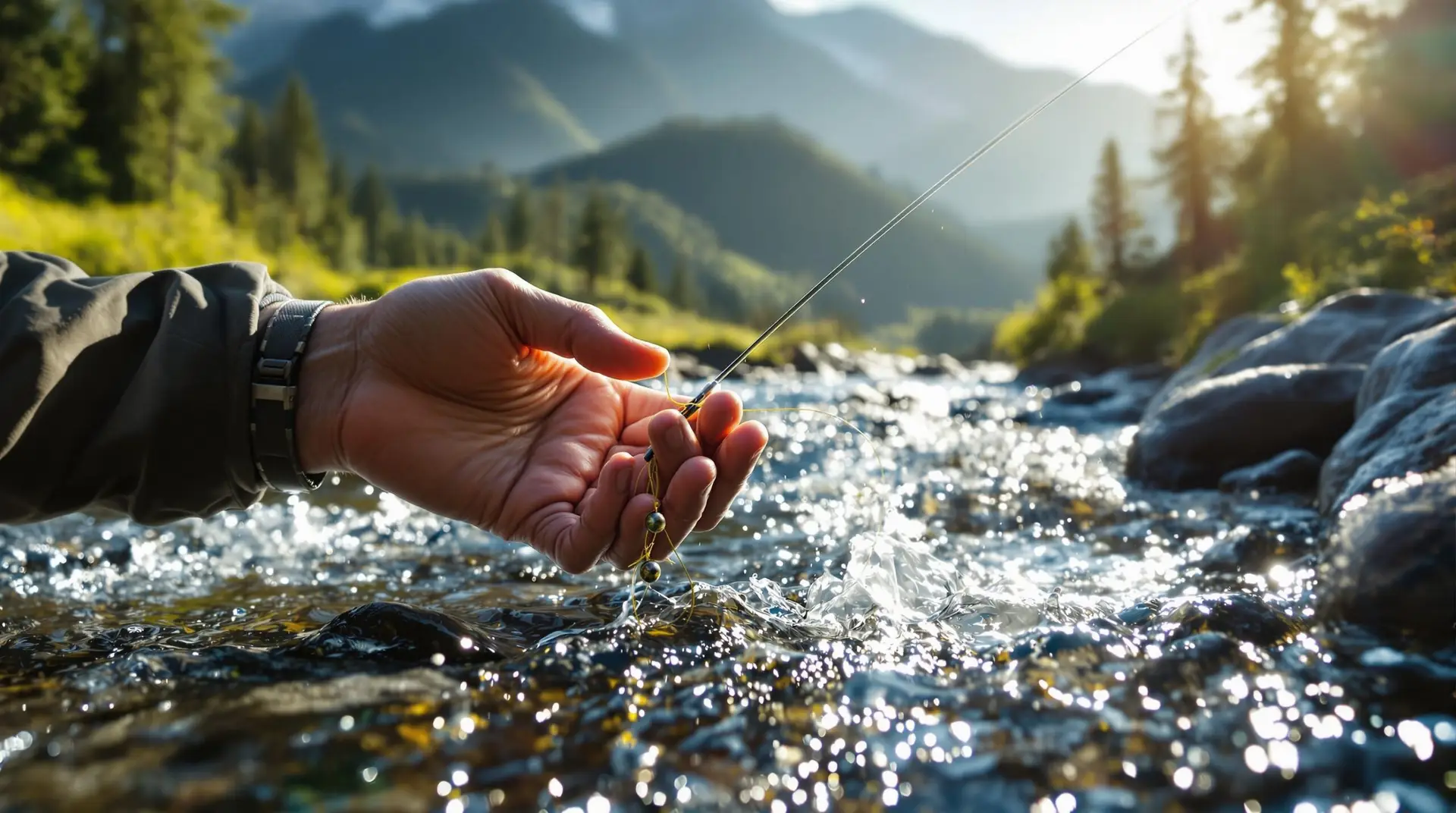Nymph Rig Weight Placement
Importance of Weight Placement
Getting the weight right on a nymph rig is like magic for those into advanced euro nymphing. A well-balanced setup means your flies hit the stream bottom fast without snagging on everything. It’s important to remember that the streambed isn’t a perfect pancake but more like a rollercoaster with all its dips and swells. Things like how fast the current runs or how thick your fishing line is can really change the game.
The trick is to weigh your rig just right so your flies can float naturally, bobbling where the fish can’t resist taking a nibble. Too much weight, and your rig drags like a reluctant suitcase. Get it right, and you’ll be reeling them in faster than your buddies. Want a scoop on drift mechanics? Check out our write-up on nymph drift mechanics.
| Factors | Impact on Weight Setup |
|---|---|
| Current Speed | Need more weight in fast-moving water |
| Tippet Diameter | Thicker lines call for heavier weights |
| Bottom Texture | Uneven beds need adjustments |
| Water Depth | More depth, more weight needed |
Playing Around with Weight for Results
Finding that sweet spot with weight placement can mean experimenting like you’re on a fishing show. Joe Humphreys, who knows a thing or two about nymph fishing, thinks you should fiddle with your weights every time you pick a new fishing spot (Fightmaster Fly Fishing). Joe believes this is the key to snagging fish others can’t seem to find, just by tweaking those weight settings.
Why go through all that trouble? Because overweighting your rig is like jamming your car brakes; underweighting leaves your flies hanging out uptown when the fish are downtown. The trick is to pack just enough to hit bottom without facing the frustration of endless snags (Orvis).
Think about switching those lead weights for tin or tungsten—same punch, less guilt. These materials won’t harm Marlin or Dolly, as they’re much kinder to the environment (Fly Fisherman). For a deeper dive on choosing the perfect bead, check our best tungsten beads nymphing section.
| Material | Properties |
|---|---|
| Lead | Dense but nasty stuff |
| Tin | Safe but not as hefty |
| Tungsten | Heavy, fish-friendly |
Mucking about with different weights and materials can fine-tune your rig to match any watery wild conditions you face. With your setup behaving like a dream, those fish won’t know what hit ’em. For more tricks and tips, swim over to our technical nymph fishing segment.
Factors Influencing Weight Placement
Getting the hang of advanced Euro nymphing isn’t just about casting a line and hoping for the best. It’s about nailing how weight’s placed on your nymph rig, considering stuff like how fast the water’s moving and the size of the tippet you’re using. Oh, and don’t forget how you chuck that line and how it drifts along.
Current Speed and Tippet Diameter
Water speed itself is a game-changer. If your nymph looks like it’s in a rush to get underwater in fast currents, you’ll need some heavy lifting—literally. Slower water? Less weight is your buddy, letting the fly glide more like it’s meant to, showing off its VIP access through different pools and runs.
Then there’s tippet diameter. Want your fly to nosedive quick? Go thin. Stronger currents, though, might bully those skinny tippets, so maybe consider beefing it up, though it’s a balance.
| Factor | Impact | Adjustments |
|---|---|---|
| Current Speed | Fast water likes heavy payloads | Add more weight, like split shot |
| Tippet Diameter | Skinny sinks fast but weaker in battle | Tweak weight depending on thickness |
Checking out our nymphing leader setup might shine some light on getting that tippet thickness just right.
Casting Technique and Drift Considerations
How you toss that line makes a big difference in where and how weight sits on nymph rigs. Start by flicking upstream; it helps the nymph dip naturally, saving you from overloading with extra weight (Coastal Angler Magazine).
Matching your drift to the current’s speed is your ace card here. Keeping things real smooth and slow keeps your fly hanging in the strike zone longer. Weight’s gotta be dialed in, or you might miss the sweet spot entirely. Packing weight into the fly can cut down on the line looking like a bird’s nest and keeps you feeling the nymph like you’ve tapped into the matrix.
| Technique | Description | Benefits |
|---|---|---|
| Upstream Casting | Allows fly to settle naturally | Cuts down on unnecessary weight |
| Weighted Flies | Weight’s built-in | Less tangles, feel every nibble, keeps it real |
Want to step up your game? Check our advanced euro nymphing guide for more juicy deets.
Getting these factors down pat helps mold your rig setup to work magic no matter the situation. To finesse your weight tweaks, pop over to our techniques for weight adjustment how-to section.
Techniques for Weight Adjustment
Perfect weight balance in nymph rigs really gets you the best drift and those sneaky fish! Two main plays can boost how you set up your nymph rig: getting the weight on the leader just right and finding the sweet spot for your fly and split shot.
Fine-Tuning Weight on the Leader
Getting the leader weight dialed in means tweaking it just enough so your nymph rig hits that sweet spot in the water. Start small—add a tad of weight, like bitsy split-shot or tungsten putty, till your fly’s kissing the bottom too much. Ease up a smidge, and you’re golden.
| Step | Action |
|---|---|
| 1 | Start small—add a bit of weight |
| 2 | See if the fly’s catching the bottom |
| 3 | Pull off some weight if it’s snagging too often |
Placing that weight about a foot up from your top fly does wonders, making sure the fly sinks just right.
Fancy yourself a fly fishing pro? Peek at our technical nymph fishing guide for more tricked-out tips.
Strategic Fly and Split Shot Placement
Wise placement of flies and split shots makes a big difference. Seasoned folks use the heft of the fly itself in the setup. Stick the heaviest, your anchor fly, at the very end, to make casting smoother, reduce slack, and keep a snug line from fly to indicator. Strike detection just got a major upgrade (Coastal Angler Magazine).
| Component | Recommended Placement |
|---|---|
| Anchor Fly | At the end (point) |
| Split-Shot | About a foot above the top fly |
Tilt your casting a dash more upstream, letting flies dive to just the right depth without piling on the weight (Coastal Angler Magazine). Saves you some hassle and extra weight.
Curious about nymph drift? Check out our piece on nymph drift mechanics for even more hacks.
Nail these weight tweaks to up your nymph rig game, and you’ll score big with the fish. Whether it’s giving the leader a stylish makeover or placing fly and split-shot just right, these tricks elevate your fishing prowess.
Optimizing Nymph Rig Weight
Getting the weight just right on a nymph rig is like seasoning a perfect meal – too much or too little and you risk ruining it. Understanding how to keep the balance, whether you’re loading up on weights or going light, can make all the difference when you’re attempting some Euro nymphing for the pros.
Overweight vs. Underweight Considerations
Heavier rigs bring a touch of magic when you’re trying to control a wild ride in turbulent waters. They help plant your line like a rock, even when the wind’s trying to do its best “blow everything out of the water” impression. But don’t overdo it, or your flies might end up dragging and snagging, making everything look a bit suspicious to smart fish.
On the flip side, using a nimbler rig lets everything move naturally, although it might be harder to keep track of your flies in a rapid stream. The trick is to hit the sweet spot that gives you a drift that flows but doesn’t lose touch.
Here’s a quick lowdown:
| Weighting | Pros | Cons |
|---|---|---|
| Overweighting | Solid control, Keeps drift stable, Great in strong currents | May look fake, Snags more often |
| Underweighting | Looks real, Avoids snagging | Harder to feel the line, Less control |
For tips that’ll make your drifts sing, check out nymph drift mechanics.
Adapting to Water Conditions
It all comes down to tuning your rig to match the water you’re tackling. Factors like how deep or swift the water is and what the bottom’s made of can nudge you on where and how to place those weights. Joe Humphreys, who’s something of a wizard with a nymph, advises changing your weight whenever you switch spots (Fightmaster Fly Fishing).
In gentler waters, let your fly move with the grace of a ballroom dancer by keeping weights on the lighter side. For those deep or racing streams, you’ll want more ballast to get your nymphs down where things happen.
Try using chain-style drop-shot rigs, where your heaviest weight ends up at the tip of your line. This method helps keep tabs on the flies while avoiding hang-ups. Tie dropper flies with long monofilament for a natural flow when things get tricky.
| Condition | What to Do with Weights |
|---|---|
| Shallow/Slow Waters | Go light for natural drift |
| Deep/Fast Waters | Add more weights, Use chain-style rig |
Fine-tuning your rig’s weight for the changing waters and homing in on the right tactics can elevate your success in advanced nymphing. For more cool tips and tricks, head over to our pages on multiple nymph rigs and competition nymphing.

